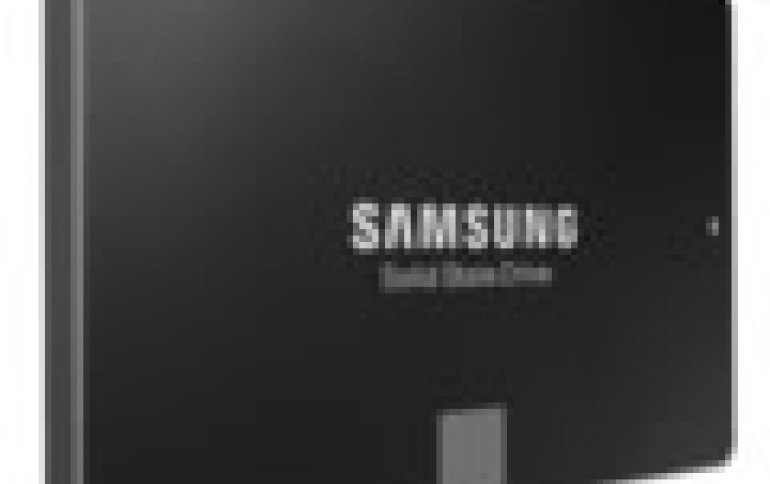
Samsung Releases New 3-bit V-NAND 850 EVO SSD
Samsung has launched the 850 EVO, the latest addition to its branded solid state drive (SSD) line-up. based on its 3-bit 3D Vertical NAND (V-NAND) technology. While the Samsung 850 PRO SSD that launched in July uses 2-bit 3D V-NAND for professional use in high-end client PCs and small- and medium-sized enterprise servers, the 850 EVO is built with 3-bit 3D V-NAND technology. This makes it more suitable for general consumer use in devices such as notebook and gaming PCs.
'Bit' is the smallest, basic unit of information in computing - the digital, binary 0 or 1. Eight(8) bits make up a byte. Flash memory chips have 'cells' which can contain a bit or multiple bits of information which eventually add up to the full memory capacity.
Samsung's new chip contains three bits per cell as opposed to one or two bits per cell, which is why it's also known as Triple Level Cell or TLC. This means each cell can store 3 bits of data instead of 2-bits/cell chip or one in the single-level cell chip. Theoretically, this means that you can have about 30% (or 33.33333333?% ? do the math ;) less cells to achieve the same memory density, which offers advantages in size and manufacturing efficiency.
However, there is a catch. While multi-level cell flash memory has these benefits, there are tradeoffs when it comes to slower write speeds and lower program-erase cycles. But Samsung says it has managed to bring up the drive's speeds and endurance up to top-notch.

The Samsung 850 EVO series comes in 1TB, 500GB, 250GB and 120GB capacity options, and boasts sequential read speeds of up to 540 megabytes per second (MB/s) and write speeds of up to 520 MB/s. With Samsung's TurboWrite technology, the 1TB version of the 850 EVO offers random write speeds of up to 90K IOPS, which enables fast storage of high volume data and multi-tasking operations.
TurboWrite is a feature that Samsung brought to the 840 EVO to increase write performance. The idea is to run a small portion of the NAND in SLC mode. All writes hit the SLC buffer first, from which they then get moved to the TLC array during idle time.
Samsung says that the new new SSD also cuts energy consumption by 30%. During an average data read, the drive uses a maximum of 3.7 watts and 4.4 watts during writes. While idle, the SSD uses 2 milliwatts of power.
Because of the greater endurance, the warranty on the 850 EVO is five years, compared with Samsung's former three-year guarantee. The 850 EVO comes in 120GB, 250GB, 500GB and 1TB models. The 250GB model can sustain 40GB worth of writes per day and up to 75TB over a five-year lifetime. The 1TB model can sustain 80GB of writes per day and up to 150TB of writes over its lifetime.
The 840 EVO hit the market with a sub-$1 per gigabyte price tag. For example, a 1TB version retailed for $599. The new 850 EVO takes that price down by $100.
The 120GB retails for $99.99, the 250GB for $149.99, the 500GB for $269.99, and the 1TB model for $499.99.
Next year, Samsung plans to introduce an extended line-up of the 850 EVO in mSATA and M.2 form factors, based on 3-bit V-NAND technology.
VNAND technology is expected to reach 100 levels of stacked NAND cells by 2017. That will offer a 1Tbit per chip density, compared to today's 2D planar density of 250Gbits per chip.
Samsung SSD 850 EVO |
||
| Capacity | 120GB, 250GB, 500GB, 1TB(1,000GB) | |
|---|---|---|
| Dimension (W x H x D) | 100 x 69.85 x 6.8 (mm) | |
| Interface | SATA 6Gb/s (compatible with SATA 3Gb/s and SATA 1.5Gb/s) | |
| Form factor | 2.5 inch | |
| Controller | 120/250/500GB : Samsung MGX controller 1TB: Samsung MEX controller |
|
| NAND Flash Memory | Samsung 32 layer 3D V-NAND | |
| DRAM Cache Memory | 256MB (120GB) or 512MB(250GB&500GB) or 1GB (1TB) LPDDR2 | |
| Performance | Sequential Read | Max. 540 MB/s |
| Sequential Write | Max. 520 MB/s | |
| 4KB Random Read (QD1) | Max. 10,000 IOPS | |
| 4KB Random Write (QD1) | Max. 40,000 IOPS | |
| 4KB Random Read (QD32) | Max. 98,000 IOPS(500GB/1TB) Max. 97,000 IOPS(250GB) Max. 94,000 IOPS(120GB) |
|
| 4KB Random Write (QD32) | Max. 90,000 IOPS(500GB/1TB) Max. 88,000 IOPS(120GB/250GB) |
|
| Data Security | AES 256-bit Full Disk Encryption (FDE) TCG/Opal V2.0, Encrypted Drive(IEEE1667) |
|
| Weight | Max. 66g (1TB) | |
| Reliability | MTBF: 1.5 million hours | |
| TBW | 120/250GB: 75TBW 500GB/1TB: 150 TBW |
|
| Power Consumption | Active Read/Write (Average): Max. 3.7W(1TB) / Max. 4.4W(1TB) Idle: Max. 50mW Device Sleep: 2mW(120/250/500GB), 4mW(1TB) |
|
| Supporting features | TRIM(Required OS support), Garbage Collection, S.M.A.R.T. | |
| Temperature | Operating: 0°C to 70°C Non-Operating: -40°C to 85°C |
|
| Humidity | 5% to 95%, non-condensing | |
| Vibration | Non-Operating: 20~2000Hz, 20G | |
| Shock | Non-Operating: 1500G, duration 0.5m sec, 3 axis | |
| Warranty | 5 Years Limited | |





















